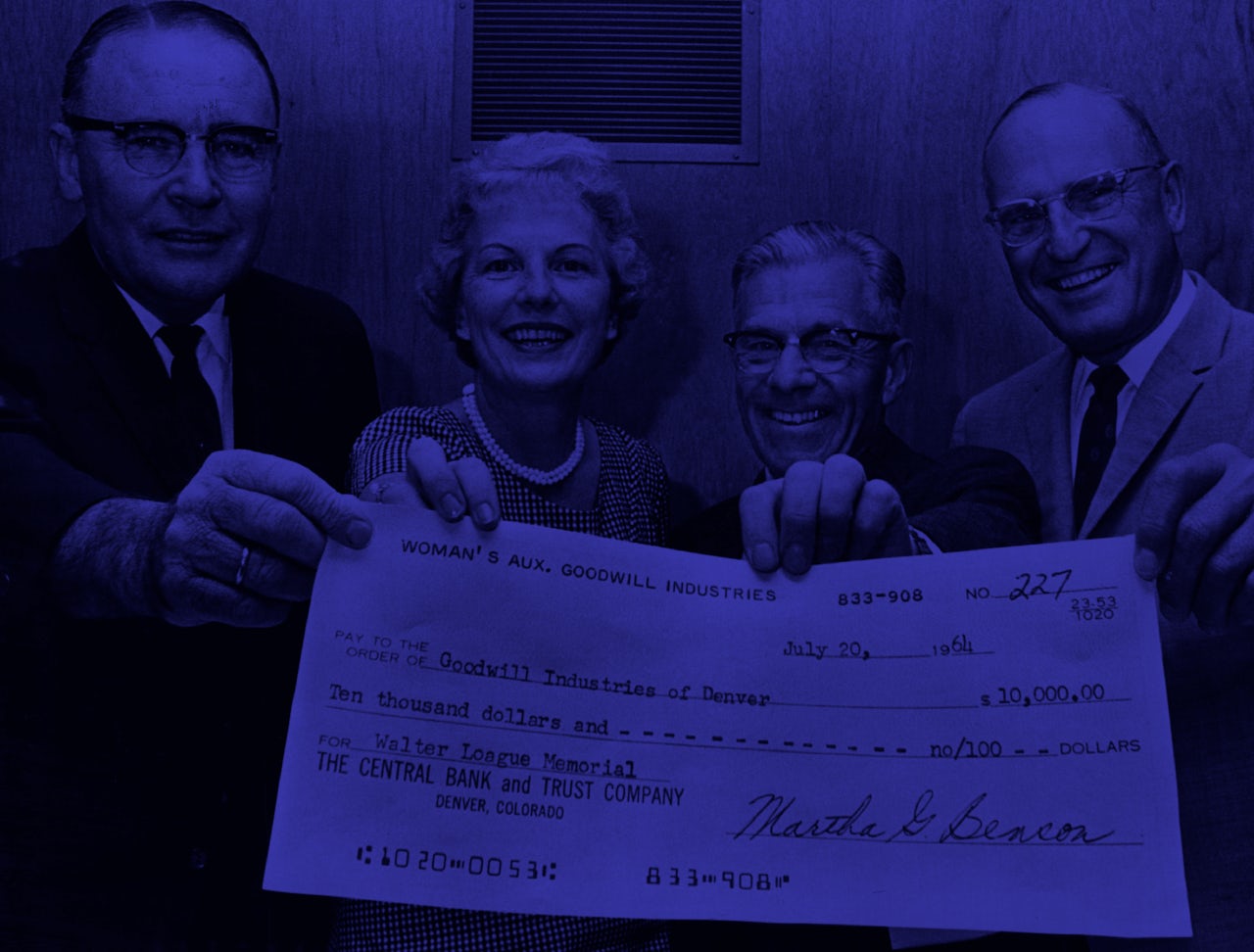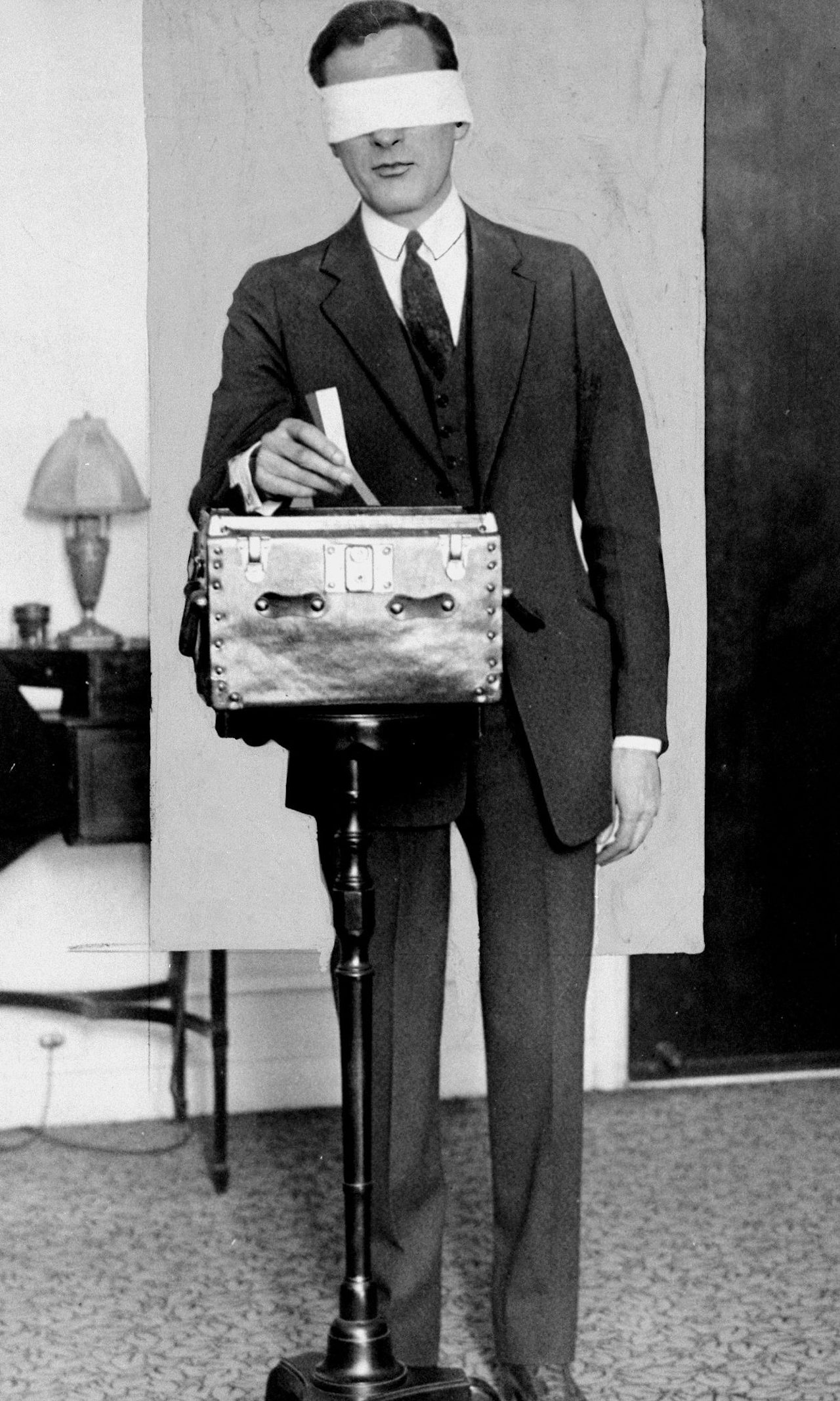Everyone has the same fantasy. The love of your life takes you to your favorite little restaurant, dimly lit and romantic, and after dessert they unveil — finally, the moment you’ve been waiting for — a gigantic novelty check written out to “THE LOVE OF MY LIFE” for the amount of “ONE LIFETIME OF LOVE.” Yes! Oh my god, yes. The newspaper photographer comes, you take a photo, you cut a ribbon; it’s a whole occasion. But have you ever wondered: What is the origin of the giant novelty check? Did it come from a witch’s curse, or two smaller checks having sex, or two even larger checks having sex, or what?
Well, no — it didn’t come from any of those. It came from Nazis.
In the earliest archived photo of an oversized check, the recipient is Joseph Goebbels. The photo, taken in 1936, shows Nazi politician Julius Lippert presenting a check for 200,000 deutschmarks to Goebbels, who holds the thin, large, floppy document delicately, staring down at, for some reason, a swastika. (Even for Nazis, I’m not sure what place a swastika has on a check. Maybe it was written in the “memo” field?) Chris Stokel-Walker dug up the photo for a wonderful piece he wrote for The Message in 2015, and it seems to be, if not the first use of an oversized check, at least the ceremonial oversized check’s first historically documented usage.
Obviously, the answer to “why do oversized checks exist” is “so you can see them better.” Non-novelty checks aren’t used much anymore — a 2013 Federal Reserve study showed use of them declined by over 50 percent from 2000 to 2012 — so I will describe what they look like for the younger readers: a much smaller version of an oversized novelty check. Can you picture it? For strictly in-person ceremonial purposes, like granting a donation to a secret scopophobic cult or paying for groceries, this size may be just fine, if less exciting. But if you want to document the money transfer, you’ll need a gigantic, exciting check.
The Goebbels photo opp occurred during the rise of photojournalism in Germany, aided by the 1924 invention of the portable 35mm Leica camera. No longer did photographers have to carry around that old-timey box-and-tripod-with-the-cloth-over-your-head equipment; the Leica’s advanced lens and compact body enabled them to more freely document goings-on like the passing of a large floppy check to Joseph Goebbels, or other things.
Photojournalism’s rise was also aided by the birth of tabloid newspapers. The U.S. got its first tabloid, called such for its more portable size at that point rather than for its content, when Joseph Medill Patterson launched New York’s Daily News, a subsidiary of the Chicago Tribune, in 1919. (My source for this information is Claude Hubert Cookman’s American Photojournalism: Motivations and Meanings, so you can trust me.) The Daily News called itself “New York’s Picture Newspaper,” and was mocked by snobbish newspaper types for its photo-heavy content.
To increase circulation, both the Daily News and the Chicago Tribune did this thing called “Cheer Checks,” which was actually borrowed (stolen) from a thing the Chicago Herald & Examiner was already doing called “Smile coupons.” Both were a spiritual predecessor to Publishers Clearing House and essentially a spiritual, uh, equivalent to the lottery: You’d get the coupons in your newspaper, and the corresponding numbers would tell you if you’d won a chunk of prize money. Local politicians would draw winning numbers and photographs of those events would would run in the papers the next morning.
Here is one of New York mayor James J. Walker doing it for the Daily News in 1925. Hi, James!
I haven’t been able to locate any photos of the recipients so I have to imagine they were awarded regular-sized checks. Still, they seem relevant, in a “big picture” sense. Let’s talk about Publishers Clearing House now.
Publishers Clearing House, arguably the most recognizable distributor of novelty checks, was founded in 1953 but it didn’t start celebrating its contest winners in the way we’ve become accustomed (novelty checks) until the late ’80s. Until that point, contest winners were reached by phone; the change was spurred by the popularization of camcorders. Prize Patrol Elite member Todd Sloane told the story of the first time the prize was awarded in-person recently on the PCH blog.
Sloane explained that in January of 1988, PCH began announcing the winning SuperPrize number on TV. “When we picked the winner for the $10,000,000, as luck would have it,” he wrote, “they lived right across the George Washington Bridge in New Jersey. We showed up the next day while they were watching the winning number announcement. [Prize Patrol Elite member] Dave Sayer and a couple of other people waited outside their house, and after the announcement ran on TV, they knocked on the door.”
For the record, you can cash novelty checks, as long as they have the right information written on them.
They screamed and jumped and whatever, but there was no evidence of the win. “‘My first question’ says Todd,” says the blog, “was ‘Did you videotape it?’ Camcorders were just beginning to get popular back in 1988, but, alas, there was no videotape!” The next time a winner was announced, Sloane purchased a camcorder at an electronics store for $1,400 and recorded the reaction himself.
I spoke with Prize Patrol Elite member Dave Sayer, who was there for the first in-person awardings, about this moment. “The winners, a young couple in Austin, Texas, screamed and jumped up and down and quickly made excited phone calls to relatives,” he said. “Their reaction alone cemented our faith in the power of this ‘reality TV’ advertising. Not long ago we were in touch with that couple who are now middle aged parents of adult children. We stay in contact with many winners who always remember the day we knocked on their doors, or surprised them at work or wherever, even in the hospital. Often the Big Check is even framed and hung on the wall.”
Aw. I wonder if Goebbels hung his on the wall? I asked Sayer what his memory of giant checks was before he started giving them out in the Prize Patrol. “I don’t recall any personal experience with what we call ‘Big Checks’ before then,” he said, “I do remember, however, being excited, as countless Americans were in the ’60s, by a TV show called The Millionaire in which a wealthy philanthropist sent his courier to the homes of needy people with million dollar standard-size checks, and I thought ‘Wow, what a great job that would be.’”
PCH continues to personally deliver the Big Checks approximately 30 times a year. (David Sayer requested that I mention Ed McMahon, who appeared in TV ads for the competing American Family Publishers, is not a PCH representative. It’s true, he’s not, and you can discover that for yourself. I’ve done my duty.)
If this piece has inspired you to award a charity or loved one with a gigantic check (and why wouldn’t it?) I can point you to a distributor I’ve discovered whose web presence I enjoy greatly. It’s a store called Big Check Store, and its web address is bigcheckstore.com. On its Facebook page you can see photos of happy customers smiling with their Big Checks. The Fresh Grocer of Progress Plaza in Philadelphia, for example, donated “5,000 pounds of food” to Philabundance, which I don’t believe you could cash, actually, even though, for the record, you can cash novelty checks, as long as they have the right information written on them. One guy won a golf thing and he got a big check. Most of the photos are of donations to charity or scholarships, but also somebody got “$530 for their Post Wedding Bliss!,” which is nice for them. Truly, when it comes to gigantic checks, the possibilities are only as limited as the check’s various lines.
Equally important is how to take the perfect gigantic novelty check photo. And I have good news — Big Check Store has you covered there, too. Here is what it suggests under the heading “BIG CHECK PRESENTATION: PHOTO SHOOT TIPS”:
When taking a picture, make sure the light is facing people in it. Having the light source at the back of the photographer will reduce the effects of shadowing in your picture. This angle will also help to make sure the check is very visible to the audience. Using a higher resolution camera will give you a better photo, so find someone with a high mega pixel camera (new smart phones work well too). Alert your local news that you are giving to a charity and if it is worth note, they will include it in the paper. Make sure you have a good picture and a list of names of who is in the picture, who is giving, and who is receiving the money. Lastly, remember to smile because you're changing someone's life.
I’m smiling right now, and that is because this piece is my oversized novelty check to you, made out to “MY NEW FRIEND” for the amount of “BIG CHECK KNOWLEDGE.” And you’re welcome.





